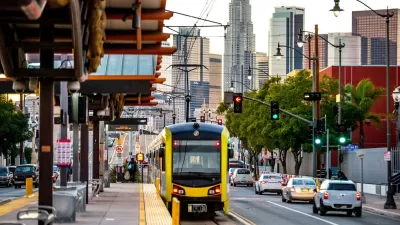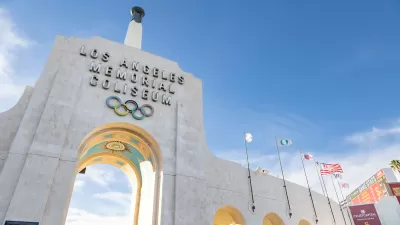In the American city most synonymous with the automobile, car ownership is declining and transit use is increasing. As the country's transportation model enters a decade of profound change, L.A. may provide the 'ultimate test' of the car’s future.
"The city that put drive-thru restaurants on the map has doubled its network of bike lanes to 292 miles (470 kilometers) and expanded light rail by 26 percent in the past eight years, with another 18 miles of track coming by 2015," writes James Nash. "Bus and train ridership is on the rise, while the total number of passenger cars registered has declined in Los Angeles County -- evidence more commuters are breaking their dependence."
"The one-family car Americans grew up with, combustion-engined and gasoline-powered, is under assault from an array of options: electric cars, hybrids and alternatives like bikes, light-rail and car-sharing plans such as the one operated by Avis Budget Group Inc. (CAR)’s Zipcar Inc. (ZIP)," he continues. "Los Angeles, the largest market in the biggest U.S. state for vehicle sales, could be the ultimate test of the conventional car’s future."
“'The next 10 years will be as important to the auto industry and transportation literally as the invention of the Model T,' Scott Griffith, former chief executive officer of Zipcar and a strategic adviser to the company, said at the Bloomberg Link Next Big Thing Summit in Half Moon Bay, California, on June 17. 'We’re now on the edge of all these new business models coming along and the intersection of information and the car and transportation. If you look out 10 years, I think we’re going to see a huge change, particularly in cities.'”
FULL STORY: L.A. Breaks Driving Addiction as Bike-Train Commutes Grow

Planetizen Federal Action Tracker
A weekly monitor of how Trump’s orders and actions are impacting planners and planning in America.

San Francisco's School District Spent $105M To Build Affordable Housing for Teachers — And That's Just the Beginning
SFUSD joins a growing list of school districts using their land holdings to address housing affordability challenges faced by their own employees.

The Tiny, Adorable $7,000 Car Turning Japan Onto EVs
The single seat Mibot charges from a regular plug as quickly as an iPad, and is about half the price of an average EV.

Engineers Gave America's Roads an Almost Failing Grade — Why Aren't We Fixing Them?
With over a trillion dollars spent on roads that are still falling apart, advocates propose a new “fix it first” framework.

The European Cities That Love E-Scooters — And Those That Don’t
Where they're working, where they're banned, and where they're just as annoying the tourists that use them.

Map: Where Senate Republicans Want to Sell Your Public Lands
For public land advocates, the Senate Republicans’ proposal to sell millions of acres of public land in the West is “the biggest fight of their careers.”
Urban Design for Planners 1: Software Tools
This six-course series explores essential urban design concepts using open source software and equips planners with the tools they need to participate fully in the urban design process.
Planning for Universal Design
Learn the tools for implementing Universal Design in planning regulations.
Borough of Carlisle
Smith Gee Studio
City of Camden Redevelopment Agency
City of Astoria
Transportation Research & Education Center (TREC) at Portland State University
City of Camden Redevelopment Agency
Municipality of Princeton (NJ)





























